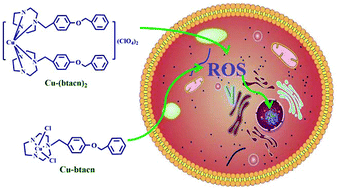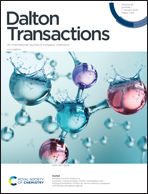Cu(ii)-TACN complexes selectively induce antitumor activity in HepG-2 cells via DNA damage and mitochondrial-ROS-mediated apoptosis†
Abstract
A new 1,4,7-triazacyclononane derivative, 4-benzyloxy-benzyl-1,4,7-triazacyclononane (btacn), and three associated cyclen complexes, Cu(btacn)Cl2, Zn(btacn)Cl2 and [Cu(btacn)2]·(ClO4)2, were prepared to serve as DNA synthesis interferents. The compounds were characterized using IR, 1H and 13C NMR, ESI-MS, elemental analysis and X-ray single crystal diffraction methods, and their DNA damage mechanisms and cytotoxicities towards cancer and normal cells were studied. Among them, Cu(btacn)Cl2 and [Cu(btacn)2]·(ClO4)2 exhibit potent anti-proliferation activity in HepG-2 and HeLa cells, but low cytotoxicity in the normal cell models LO2 and HUVEC, giving SI values (IC50 ratios) ranging from 2.45 to 7.09-times higher than that of cisplatin. DNA binding and cleavage studies suggested that [Cu(btacn)2]·(ClO4)2 can more easily intercalate into CT-DNA than Cu(btacn)Cl2, which is consistent with the results of G2/S phase arrest and apoptosis in HepG-2 cells involving the complexes. In contrast, Zn(btacn)Cl2 demonstrated weak DNA binding and no obvious cytotoxicity. The results suggest that Cu(btacn)Cl2 and [Cu(btacn)2]·(ClO4)2 mainly undergo redox processes to produce reactive oxygen species (ROS) that induce DNA degradation and mitochondrial damage.



 Please wait while we load your content...
Please wait while we load your content...